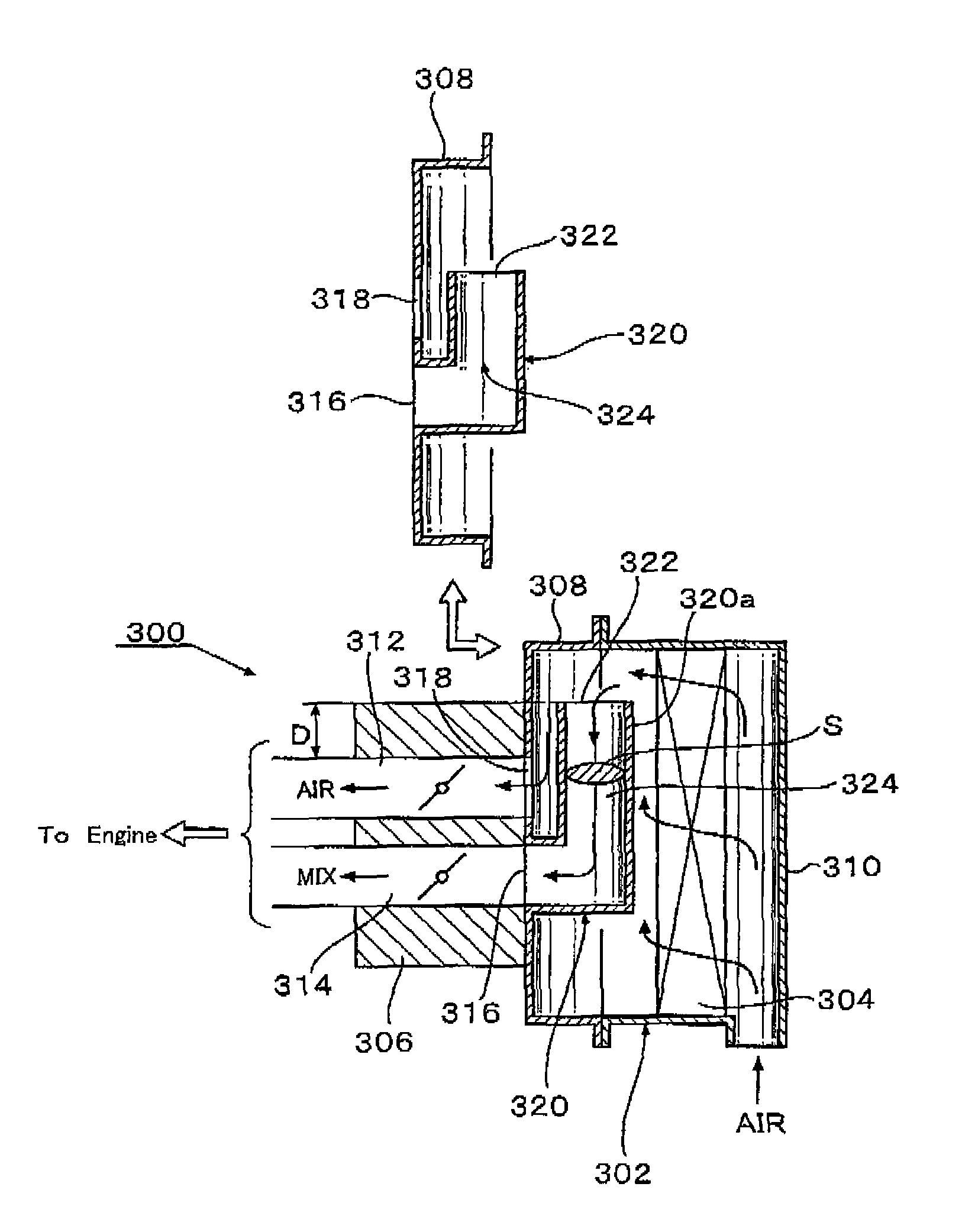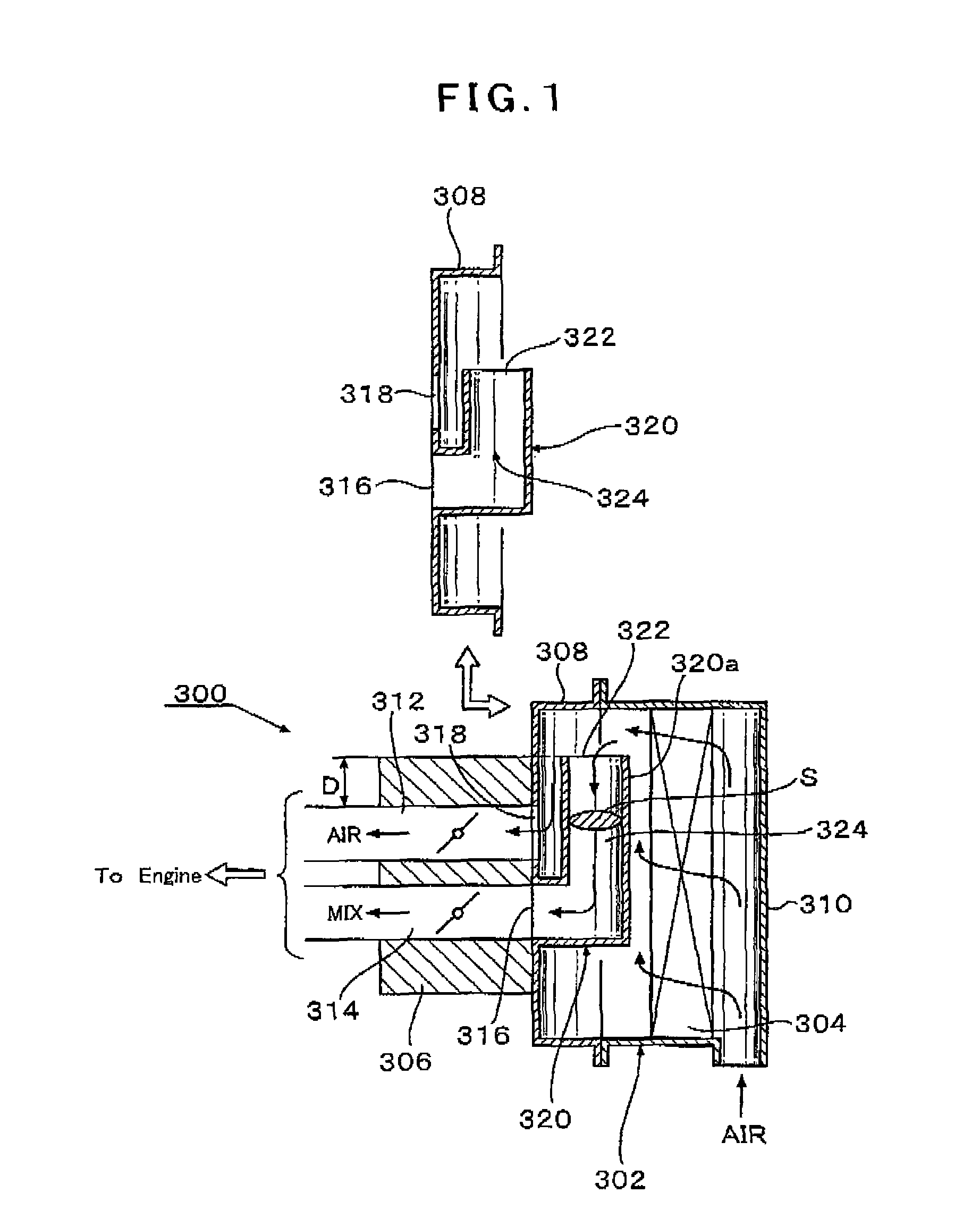Air cleaner for two-stroke internal combustion engine and method of tuning the length of air-fuel mixture passage by using the air cleaner
a technology of air cleaner and internal combustion engine, which is applied in the direction of combustion-air/fuel-air treatment, auxillary pretreatment, and separation processes, etc., can solve the problems of difficult to take effective measures to reduce emissions of two-stroke engines, and discharge of unburnt components from engines, so as to reduce harmful emissions of exhaust gas
- Summary
- Abstract
- Description
- Claims
- Application Information
AI Technical Summary
Benefits of technology
Problems solved by technology
Method used
Image
Examples
first embodiment
FIGS. 17 to 23
[0096]With reference to FIG. 17, the air cleaner 55 includes an air cleaner base 61 and an outer case 62 that, in combination, define an air cleaner chamber 66 (FIG. 16). An air cleaner element 67 composed of a lower element 63 and an upper element 64 is held in a predetermined position within the air cleaner chamber 66. Filters 63a, 64a that may be plastic molded nets, meshed fabric, or paper sheets having fine bores, and held on frames 63b, respectively, are fixed to the lower element 63 and the upper element 64.
[0097]The air cleaner base 61 is detachably connected to the upstream end of the carburetor 54 by bolts (not shown). With reference to FIG. 17, the air cleaner base 61 has an air-fuel mixture opening 70 enclosed by an upright tubular circumferential flange 69. The air-fuel mixture opening 70 is disposed in alignment with a position of the air-fuel mixture passage 54b of the carburetor 54. Although both the air-fuel mixture opening 70 and the circumferential f...
second embodiment
FIG. 24
[0122]The second embodiment is directed to an air cleaner in which the air guide member 65 is partly defined by the lower element 63. The lower element 63, in combination with the upper element 84 (FIG. 17), defines the air cleaner element, and the lower element 63 has a second tubular boss 80 corresponding to the first tubular boss 71 (communicating with the fresh air passage 54a of the carburetor 54) of the air cleaner base 61 and a first inlet 83 communicating with the air-fuel mixture opening 70 (communicating with the air-fuel mixture passage 54b of the carburetor 54) of the air cleaner base 61.
[0123]In this embodiment the lower element 63 has a bottom wall 100 extending in a bilateral direction with respect to the first inlet 83 in a U-shaped geometry in its plan view, and the bottom wall 100 has first flanges 100a along its both side edges. The bottom wall 100 defines a part of the air guide member 65.
[0124]That is, in this embodiment, the air guide member 65 is compos...
third embodiment
FIG. 25
[0127]The third embodiment is directed to an air cleaner 55 having a modified air cleaner element 67. The air cleaner element 67 used here has a shape of a ring as a whole. The ring-shaped air cleaner element 67 is assembled in the air cleaner 55 in a configuration sandwiched between the air cleaner base 61 and a top plate 122 that are spaced apart from each other. Then, a cover 124 is assembled to cover the entirety of the air cleaner base 61, air cleaner element 67 and top plate 122. Note that the air guide member 65 used in the third embodiment is a tubular member curved in an L-shaped geometry when viewed in a side elevation, and the L-shaped tubular member 65 is in detachable fitting engagement with the circumferential flange 69 around the air-fuel mixture opening 70 of the air cleaner base 61.
PUM
| Property | Measurement | Unit |
|---|---|---|
| angle | aaaaa | aaaaa |
| length | aaaaa | aaaaa |
| lengths | aaaaa | aaaaa |
Abstract
Description
Claims
Application Information
 Login to View More
Login to View More - R&D
- Intellectual Property
- Life Sciences
- Materials
- Tech Scout
- Unparalleled Data Quality
- Higher Quality Content
- 60% Fewer Hallucinations
Browse by: Latest US Patents, China's latest patents, Technical Efficacy Thesaurus, Application Domain, Technology Topic, Popular Technical Reports.
© 2025 PatSnap. All rights reserved.Legal|Privacy policy|Modern Slavery Act Transparency Statement|Sitemap|About US| Contact US: help@patsnap.com



